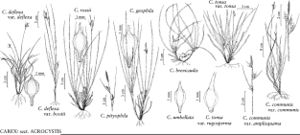Carex brevicaulis
Bull. Torrey Bot. Club 40: 547. 1913.
Plants densely to loosely cespitose; rhizomes horizontally spreading to ascending, brown to reddish brown, 0–10 mm, slender or stout. Culms 2–19 cm, strongly scabrous distally; bases and remnants of old leaves slightly fibrous. Leaf blades pale green, exceeding stems, 1.3–2(–3.5) mm wide, herbaceous to coriaceous, glabrous abaxially, scabrous to papillose adaxially. Inflorescences with both staminate or pistillate spikes; peduncles of basal spikes erect, elongate, slender; peduncles of staminate spikes 1.7–8.5(–21) mm; proximal nonbasal bracts scalelike, usually equaling or shorter than inflorescences, rarely longer. Spikes: proximal pistillate spikes 2–5 (basal spikes 1–3); cauline spikes usually separated, with 1–6 perigynia; staminate spikes 5.7–14.4 × 0.9–2.1 mm. Scales: pistillate scales reddish brown with narrow white margins, ovate, 3.2–6 × 2–2.2 mm, equaling or exceeding perigynia, apex acute to acuminate (short-awned in some basal spikes); staminate scales lanceolate, 4.1–5.1 × 2 mm, apex acute to obtuse. Anthers 2–2.5 mm. Perigynia pale bright green, finely 12–15veined near base, globose, round in cross section, 3.5–4.8 × 1.7–2.1 mm; beak straight, pale green, not strongly 2-edged, 0.6–1.6 mm, ciliate-serrulate, apical teeth 0.2–0.5 mm. Stigmas 3. Achenes brown, globose to obovoid, round in cross section, 1.9–2.4 × 1.6–2 mm. 2n = 28.
Phenology: Fruiting late Mar–late Jun.
Habitat: Dry, open, sandy or rocky slopes, cliffs, and dunes
Elevation: 0–90 m
Distribution

B.C., Calif., Oreg.
Discussion
Selected References
None.
